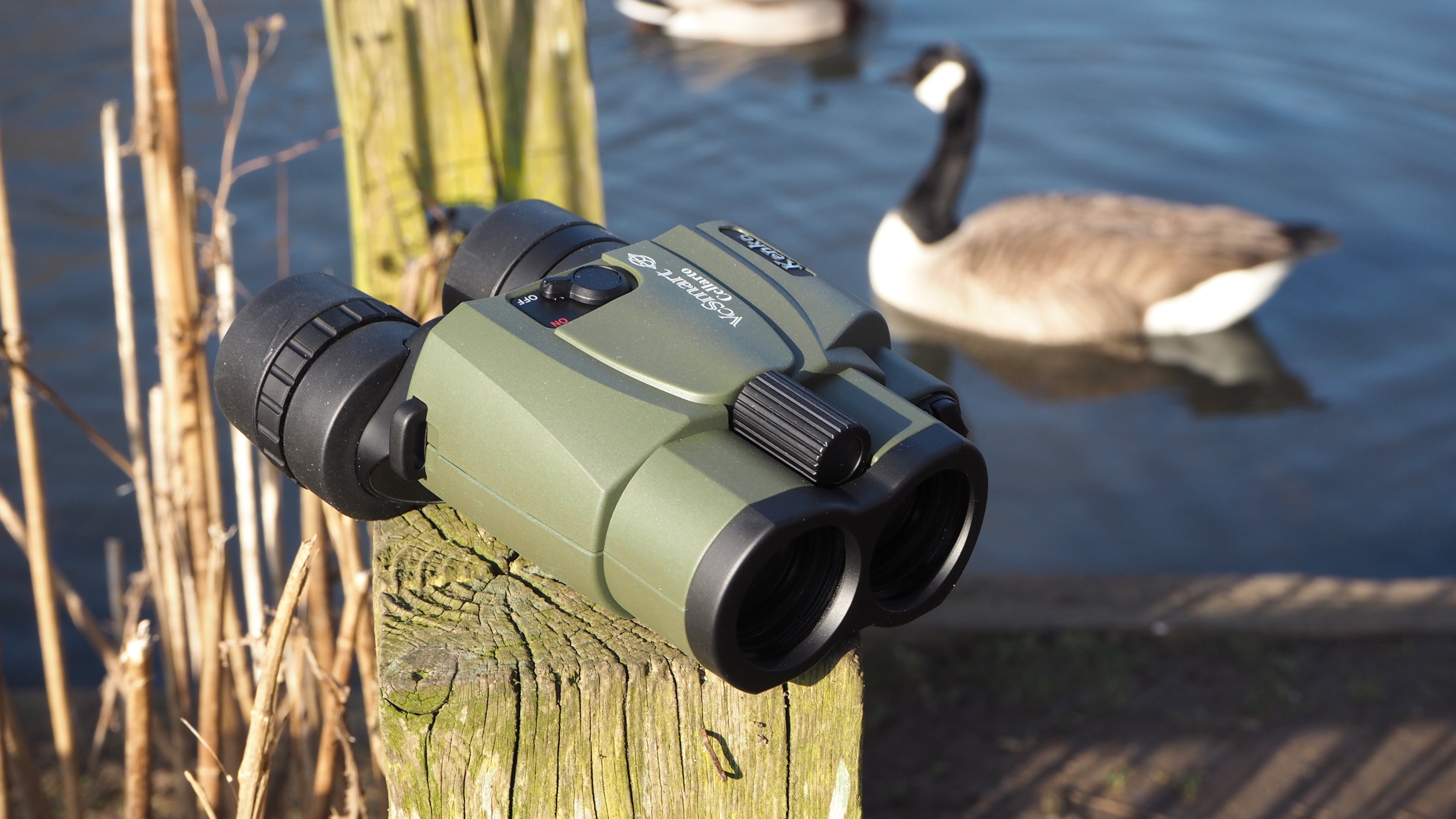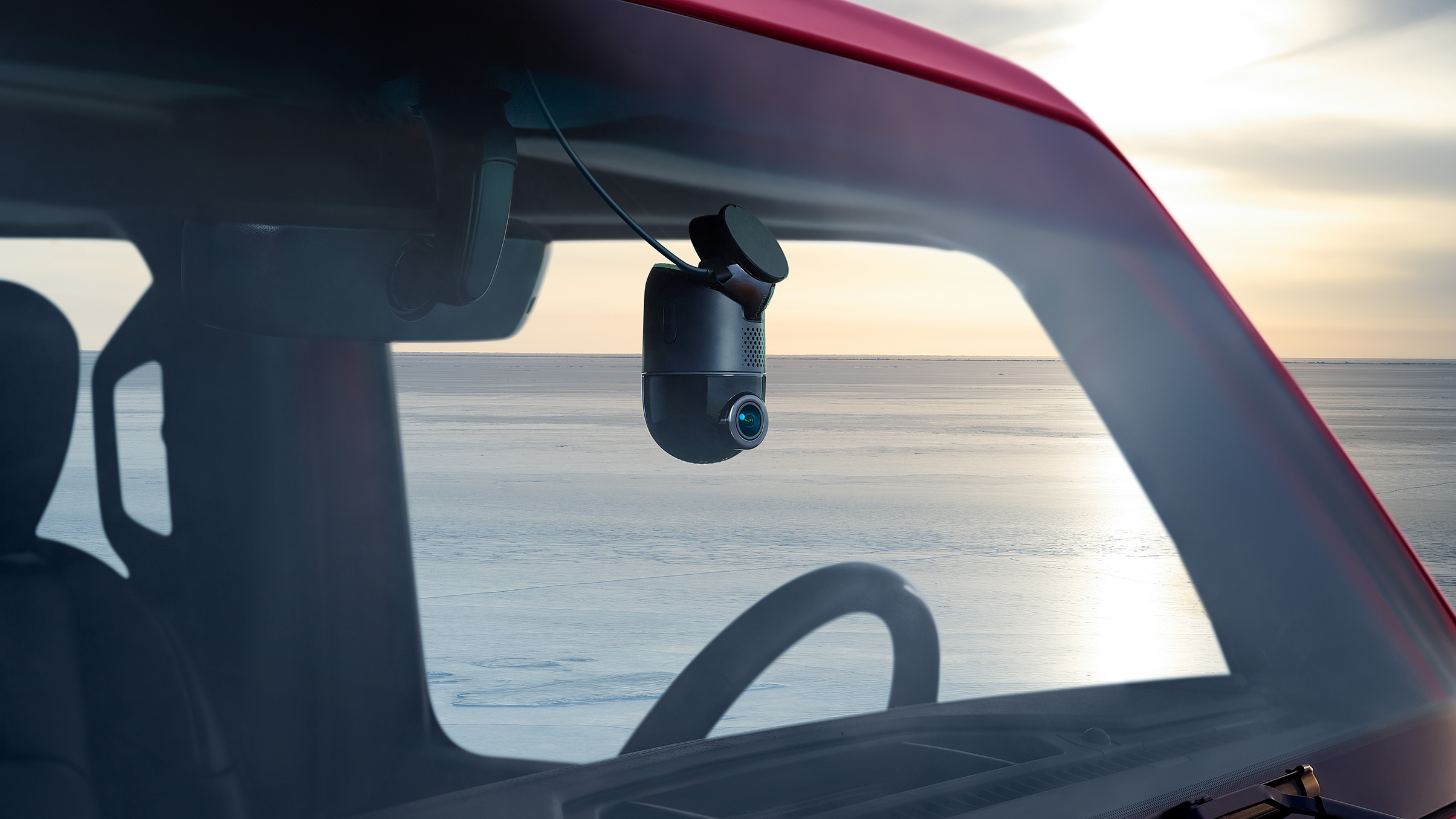Digital Camera World Verdict
Is the Kenko VC Smart Cellarto 10x30 WP worth looking into? Not only is it a high-quality Japanese-made binocular delivering a reassuringly sharp image free of obvious aberrations, it also boasts the advantage of an intelligent or ‘smart’ on-board image stabilizer. Not wholly essential given the standard 10x magnification perhaps, yet anyone who has used binoculars with this vibration correcting feature will certainly appreciate it’s one worth having in terms of reducing eye strain. If they don’t mind paying a premium over a non-IS model for such a belt-and-braces feature, that is. Overall I was impressed with the sharp, three dimensional quality of observation delivered by this binocular, enabling the identification of small details from afar, which means that it comes recommended in its price category and ‘IS’ enabled class.
Pros
- +
Built-in vibration correction automatically helps cancel out any hand wobble and prevent image judder
- +
Good quality, well-constructed and solid feeling Japanese product
- +
Uniformly sharp views, free from chromatic aberration even in bright sunligh
Cons
- -
Image stabilisation is more desirable than essential at this fairly modest level of magnification, so some may feel the added cost and weight isn’t worth it
- -
We’ll have to supply our own AA batteries to power its IS feature, although these are included if buying the bino in its native Japan
- -
Strong competition from Canon, Nikon and Fujifilm in this price bracket and category
Why you can trust Digital Camera World
When seeking a pair of binoculars as a tool to bring the faraway closer, I’m always looking to find the ideal balance between size, weight, and performance. The bigger the magnification and the brighter the objective lens, normally the bigger and heavier the bino, resulting in me taking it out less. So, something compact and portable that will get some actual use is preferable.
Yet the trouble with physically smaller binos with a decent magnification is the potential for visible judder when looking through its eyepieces, meaning subjects under observation appear to ‘dance’ before our eyes; an amplification of any hand tremor from the user.
Enter the Kenko VC Smart Cellarto 10x30 WP binocular. Photographers will know this brand because of Kenko’s Tokina lenses, but the main talking point here is the built-in AA battery-powered image stabilization system, aiming to cancel out any effects of hand wobble and deliver a smooth and steady image. Of course, everything today has to be termed ‘smart’ – even vibration control.
Once Canon ruled the roost for this binocular market segment and charged what it wanted, but now Fujifilm with its Techno-Stabi series and Nikon with its ‘Stabilized’ 10x25 and 12x25 options offer strong alternatives.
Just as the letters ‘VC’ indicate vibration correction is on board, it will come as no surprise to find the suffix ‘WP’ on this latest Kenko pretender nods to the fact this one also boasts a degree of waterproofing. It’s been primarily designed for outdoor use and for hobbies such as birding or star-gazing. If you’re wondering, ‘Cellarto’ alludes to the Latin word ‘Celeritas’. Its maker has interpreted this as meaning ‘to select and switch quickly’.
Looking sufficiently high-tech yet 70s retro that it could be utilized in some Star Wars spin-off, given all of the above, does the high-tech Kenko VC Smart Cellarto 10x30 WP binocular prove to be one binocular worth looking into?
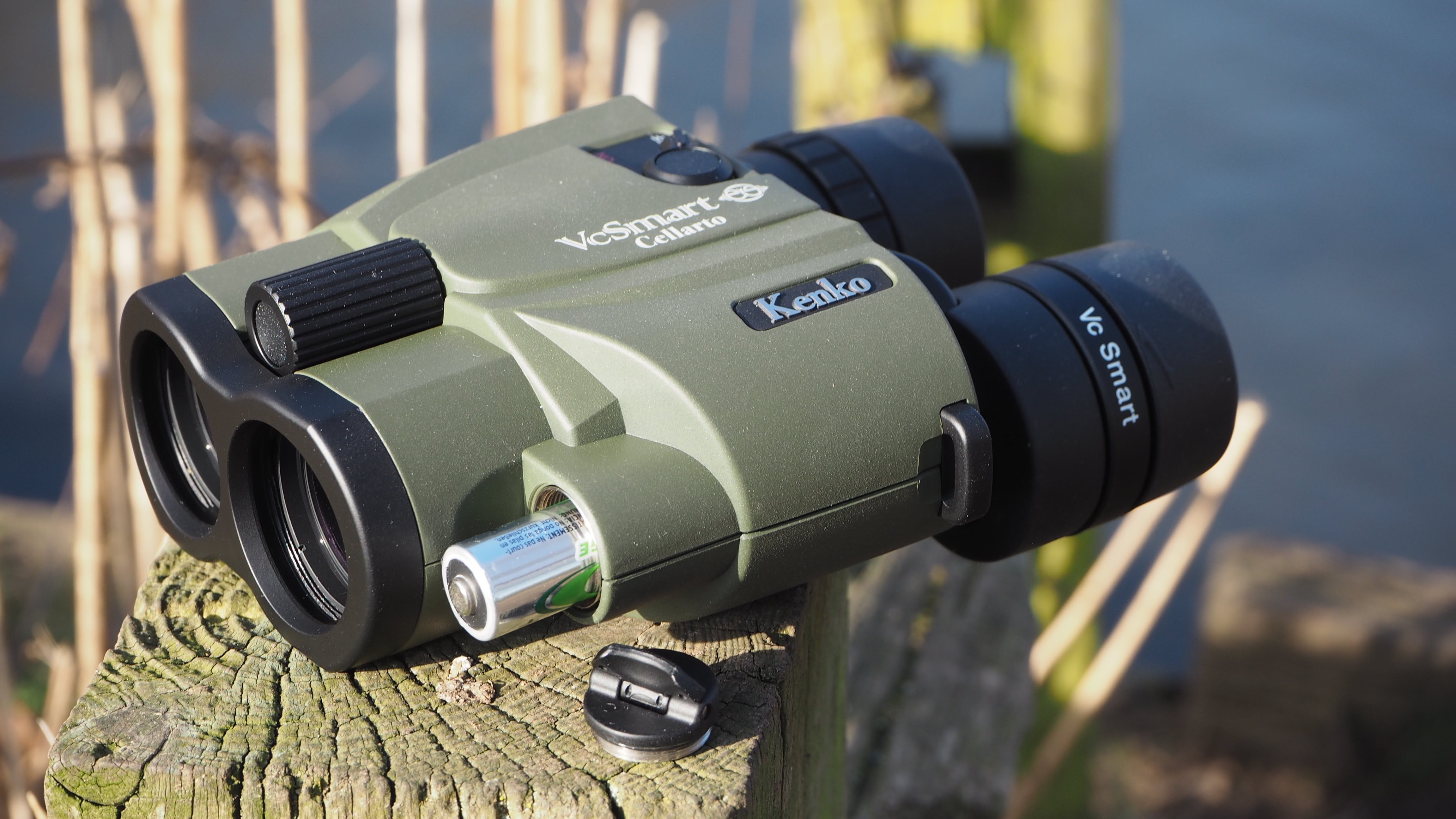
Kenko VC Smart Cellarto 10x30 WP: Specifications
Magnification | 10x |
Objective lens size | 30mm |
Field of view at 1000m | 90.8m |
Power | 1x AA battery lasts 28 hours of continual use |
Dimensions | 147 x 51 x 124 mm |
Weight | 533g |
Kenko VC Smart Cellarto 10x30 WP: Price
Though released July 2024 in Japan, the Kenko VC Smart Cellarto 10x30 WP is newly available in the West at the time of writing. Listed at 100,000 Yen, the equivalent of £520 or $650 here, this is obviously a premium product that falls into line in terms of sophistication, price and performance with rivals from Canon, Nikon and Fujifilm; to name but three key players in this segment, I’d always expect to be paying more for a binocular with on-board vibration correction and, given this, what Kenko is asking seems fair, if unsurprising.
Kenko VC Smart Cellarto 10x30 WP: Design & Handling

Broadly the width of a paperback novel, while a quarter shorter in height, the Kenko VC Smart Cellarto 10x30 WP will squeeze into a roomier jacket pocket, though a Velcro-fastened carry pouch with a loop at the back to thread a belt through is provided. While this is fashioned from inexpensive-looking fabric with what I presume to be faux leather detailing, we also get a lens cloth and neck strap, so the basics are covered.
To drill a bit more into the main selling point here, this binocular is ‘smart’ not just because it offers the user vibration correction at the flick of a top-mounted on/off switch, but because it claims to automatically select the optimum type of image stabilization. This device determines this dependent on whether the user is actively panning with the bino, which its maker classifies as ‘large vibration’, or viewing a stationary object, where there might just be minor hand tremble classified as ‘fine vibration’. There’s no need for us as users to actively swap between one mode or another, we just continue to re-frame and re-focus on our subjects as necessary.
Of course, if the inserted AA battery runs out of juice or we simply want to preserve power when out and about for whenever we need it most, then there is the option to use the Kenko VC Smart Cellarto 10x30 WP just like any other standard binocular, with its image stabilization turned off. The optical performance alone impresses me, as I’ll get to in a moment.
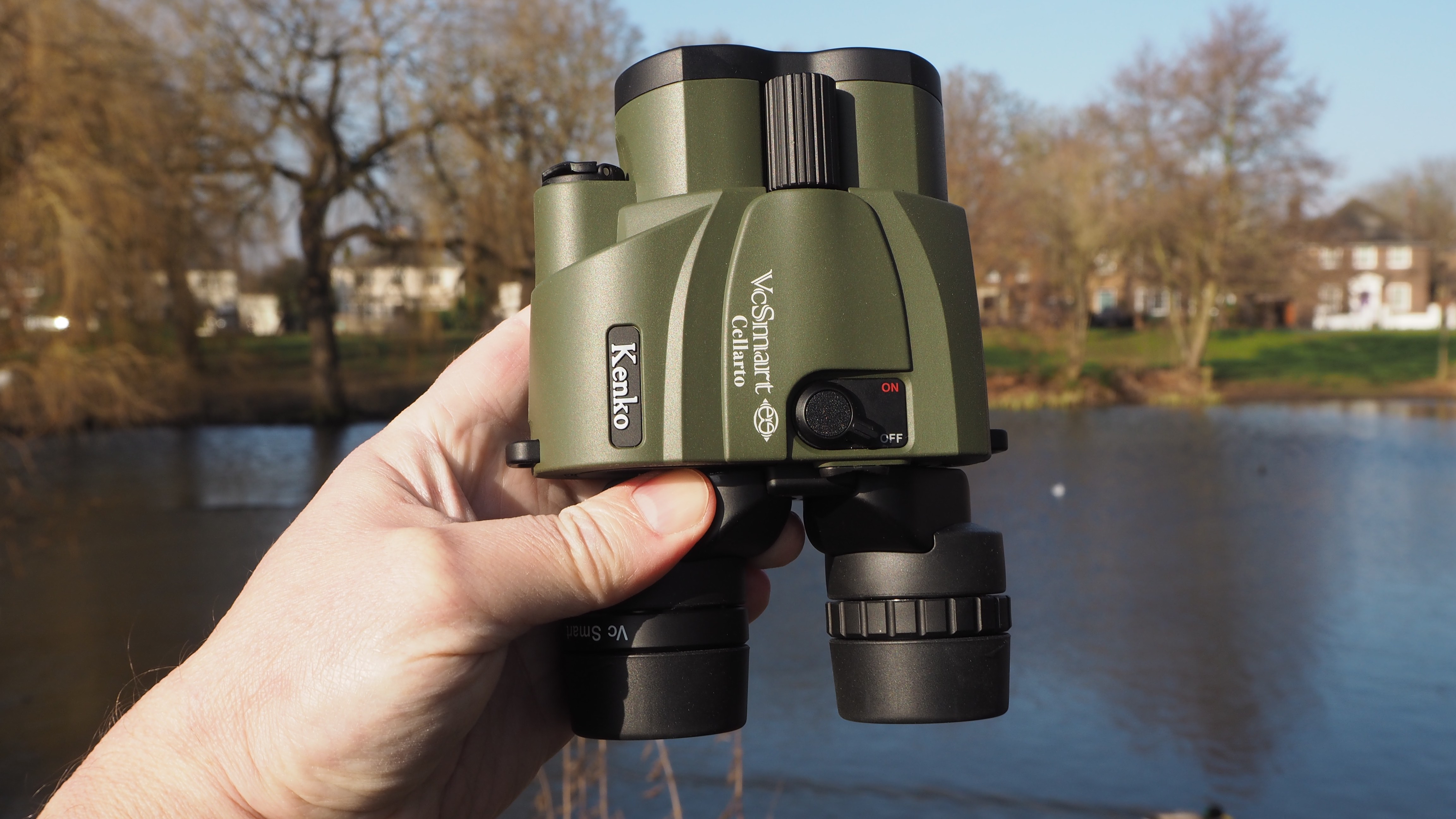
Kenko VC Smart Cellarto 10x30 WP: Performance
In fact, the performance of the Kenko VC Smart Cellarto 10x30 WP binocular is expectedly better than most budget models, even without its battery-powered gadgetry, and notably on a par with, if not slightly better than, similarly priced alternatives. It shows its premium mettle in the sharp and clear observation it provides, thanks in part to all its lenses and light-reflecting prisms being fully multi-coated. This helps enhance and maximize light transmission and deliver a bright image.
The binocular’s relatively flat design – give or take the handily raised and ridged focus control – has been enabled by the battery compartment being placed to one side, rather than in the middle, sitting almost unobtrusively next to the objective lens at the front. If there’s a minor gripe, I found retrieving and inserting the battery a little fiddly, due to it being flush up against the lens housing. There is also a subtly roughened surface to the green-colored main body of the binocular without it being coarse. This reassured me that I could maintain a firm grip, even if the device itself was being dampened by light drizzle outdoors. Also enabling a steady hold is the polycarbonate resin constructed body’s total weight of 533g. This leaves the device feeling solid, yet not unmanageable.

When we do want to activate the Kenko’s onboard vibration correction, we’re told the single AA battery should last us a very generous 28 hours of continuous use. On a practical note, that should last the casual user for months. Should we forget to flick the lever to ‘off’, and an auto power-off function kicks in after an unspecified period? There’s also a small pilot light that shows the binocular has power/ is in use, next to which is cleverly a sliding plastic shutter, for hiding said light if we’re viewing a concert performance for example, and don’t want to prove a distraction. Or any more of a distraction than fellow audience members using mobile phones might be!
Also allowing for a more comfortable and optimal viewing experience is the fact that the inter-pupillary distance between the binocular’s tactile rubber-encased eyepieces is adjustable. In my mind these have just the right amount of ‘give’, allowing for swift and easy adjustment without feeling so loose that we’ll have to keep re-positioning them when fetching the unit out of a jacket pocket or bag.
Performance with or without ‘VC’ active is sufficiently impressive as to render the yellow irises of the tufted ducks on my local reservoir with a pinhead-like sharpness. Detail was also such that I could observe the fact that their beaks, which look white at a distance, are in fact a subtle shade of egg blue when viewed through the Kenko. Similarly, what appear to be black feathers also glow a little purplish when reflecting sunlight. These are subtle details that can’t be picked up at normal viewing distance, but can, thankfully, at 10x magnification. I would have no hesitation therefore in suggesting this device as a good means of identification for any dedicated birder. As expected, activating the vibration correction feature even when standing stock still and viewing fairly stationary wildfowl does make for greater comfort and a more natural three-dimensional viewing experience. It’s as if we have ‘zoomed’ in with our own eyes rather than getting a secondhand view through prisms and lenses.
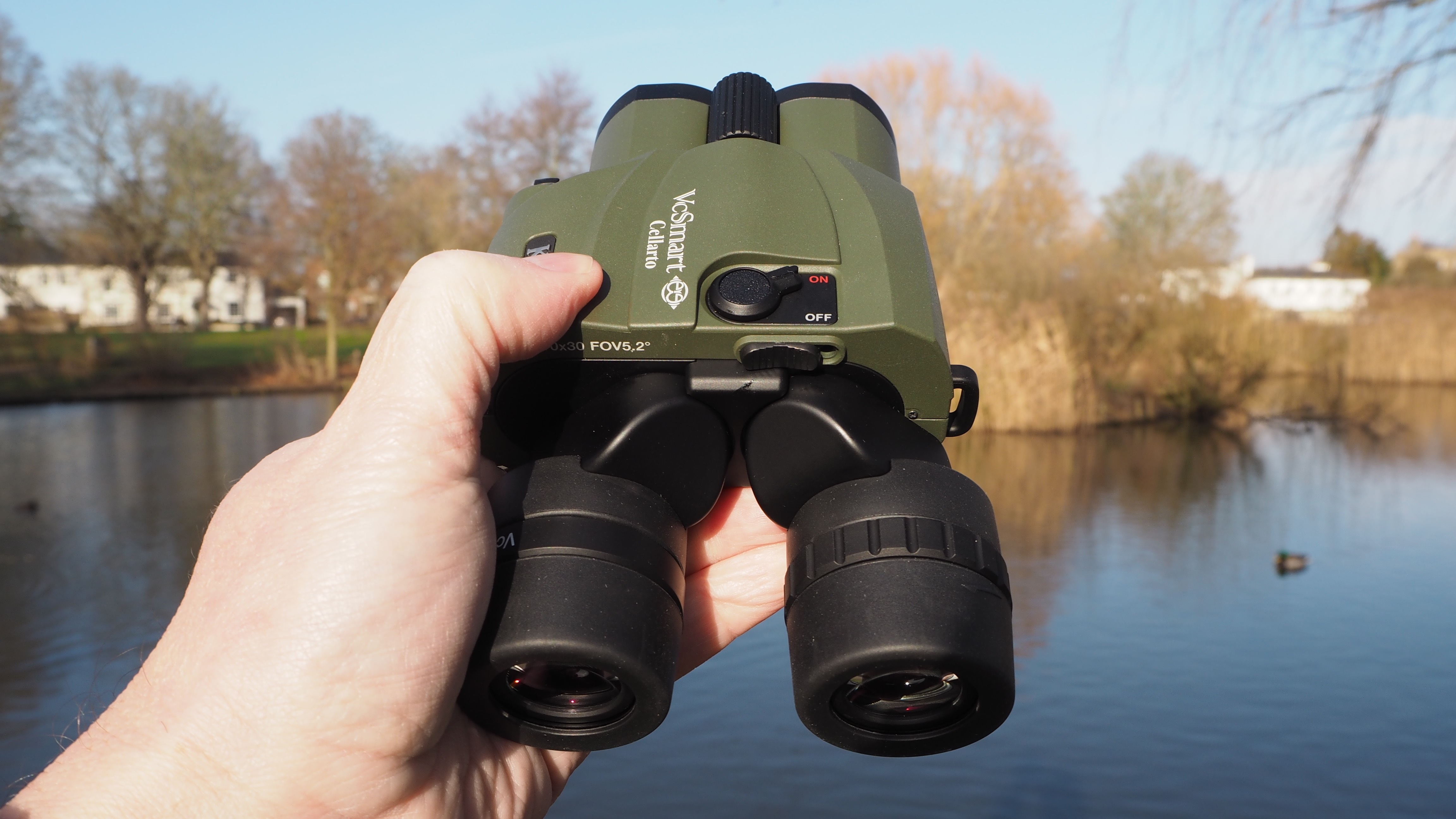
Kenko VC Smart Cellarto 10x30 WP: Verdict
While it’s great to have the option of on-board image stabilization/vibration correction in theory, it could be argued that given the magnification of the Kenko VC Smart Cellarto 10x30 WP is a fairly modest 10x, the need for the feature is not as essential in practice as it would be for, say, a 16x model. There are plenty of 10x binoculars without on-board IS that are perfectly usable and cost a fraction of the price. If you’re looking to undertake observation for prolonged periods, however, then having vibration correction is less tiring on the eyes, and here’s where it comes into its own a lot more, even on a 10x30 bino.
Build quality is as high as we’d expect to find on a product that proudly proclaims it is Japanese-made, while sharpness enables an impressive level of identification of subtle details on subjects, from afar, which is what most of us will be considering a binocular for in the first place.
Design | Futuristic and high tech looking, in a similar style to competitor Fujifilm’s Techno-Stabi series, complete with width adjustable eyepieces jutting out from the body at angles reminiscent of frog’s legs. | ★★★★☆ |
Performance | Very simple and intuitive to use with a raised and ridged focus wheel dead centre, a dioptric adjustment ring plus twist up eye cups enable the device to quickly become an enhanced version of the user’s own eyesight. | ★★★★☆ |
Value | Inevitably we are going to be paying more for a binocular with a built-in vibration cancelling gyro sensor over a bog standard fully analogue model, and the batteries needed to go with it. That said the pricing here feels fair when compared to similarly equipped alternatives from the big names as discussed. | ★★★★☆ |
Alternatives
Canon, Fujifilm, and Nikon are the bigger name brands to beat when it comes to weighing up if the Kenko VC Smart Cellarto 10x30 WP binocular is the right choice for you if binos with built-in image stabilization are a must. Recent options from Nikon, with which it re-entered the market in 2024 include its ‘Stabilized’ 10x25 and 12x25 models, identical save for differing magnifications. Powered by two AA batteries, that last 12 hours, stored beneath a latch between the eyepieces, Nikon’s offering is more compact and more portable than what we’re looking at here. That’s partly thanks to smaller objective lens, although the design is likewise more basic and less swish-looking than Kenko’s in my opinion.
Boasting a closer form factor to Kenko’s offering is Fujifilm’s Techno-Stabi (stabilized) TS 16x28 WP model, which at the same time offers a more powerful magnification that more keenly justifies its on-board ‘IS’, along with a decent level of brightness thanks to its 28mm objective lens. Powerful, compact, and waterproof with it, I’d recommend trying this Fuji option out for size alongside the Kenko before sealing the deal.
Canon’s comparable offerings are typically older, and bulkier, as well as being rather expensive, partly due to the virtual monopoly on ‘IS’ equipped binos it has enjoyed up until recently.
One of its more recent examples however is the made-in-Japan Canon 12x36 IS III, which resembles its Fuji and Kenko rivals on steroids. Again, we get a decent magnification and a large objective lens, suggesting a best-of-both-worlds performance in terms of reach, sharpness, and brightness, while pricing is likewise similar. I have to say though, I do prefer the handling and the feel of the Kenko, as opposed to Canon’s rather more basic-looking rubberized tool.
Gavin has over 30 years’ experience of writing about photography and television. He is currently the editor of British Photographic Industry News, and previously served as editor of Which Digital Camera and deputy editor of Total Digital Photography.
He has also written for a wide range of publications including T3, BBC Focus, Empire, NME, Radio Times, MacWorld, Computer Active, What Digital Camera and the Rough Guide books.
With his wealth of knowledge, Gavin is well placed to recognize great camera deals and recommend the best products in Digital Camera World’s buying guides. He also writes on a number of specialist subjects including binoculars and monoculars, spotting scopes, microscopes, trail cameras, action cameras, body cameras, filters and cameras straps.
You must confirm your public display name before commenting
Please logout and then login again, you will then be prompted to enter your display name.
